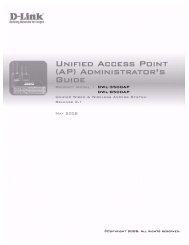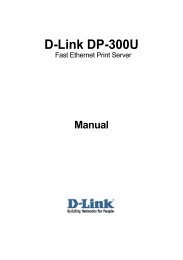Product Manual
Product Manual
Product Manual
Create successful ePaper yourself
Turn your PDF publications into a flip-book with our unique Google optimized e-Paper software.
Client<br />
DES-3526 / DES-3526DC Fast Ethernet Layer 2 Switch<br />
The Client is simply the workstation that wishes to gain access to the LAN or switch services. All<br />
workstation must be running software that is compliant with the 802.1x protocol. For users running<br />
Windows XP, that software is included within the operating system. All other users are required to<br />
attain 802.1x client software from an outside source. The Client will request access to the LAN and or<br />
Switch through EAPOL packets and, in turn will respond to requests from the Switch.<br />
Authentication Process<br />
Figure 6- 70. Client<br />
Utilizing the three components stated above, the 802.1x protocol provides a stable and secure way of<br />
authorizing and authenticating users attempting to access the network. Only EAPOL traffic is allowed<br />
to pass through the specified port before a successful authentication is made. This port is “locked”<br />
until the point when a Client with the correct username and password (and MAC address if 802.1x is<br />
enabled by MAC address) is granted access and therefore successfully “unlocks” the port. Once<br />
unlocked, normal traffic is allowed to pass through the port. The D-Link implementation of 802.1x<br />
allows network administrators to choose between two types of Access Control used on the Switch,<br />
which are:<br />
1. Port-Based Access Control – This method requires only one user to be authenticated per port by<br />
a remote RADIUS server to allow the remaining users on the same port access to the network.<br />
2. MAC-Based Access Control – Using this method, the Switch will automatically learn up to<br />
sixteen MAC addresses by port and set them in a list. The Switch using a remote RADIUS<br />
server before being allowed access to the Network must authenticate each MAC address.<br />
Port-Based Network Access Control<br />
The original intent behind the development of 802.1x was to leverage the characteristics of point-topoint<br />
in LANs. Any single LAN segment in such an infrastructures has no more than two devices<br />
attached to it, one of which is a Bridge Port. The Bridge Port detects events that indicate the<br />
attachment of an active device at the remote end of the link, or an active device becoming inactive.<br />
These events can be used to control the authorization state of the Port and initiate the process of<br />
authenticating the attached device if the Port is unauthorized. This is the Port-Based Network Access<br />
Control.<br />
101

















